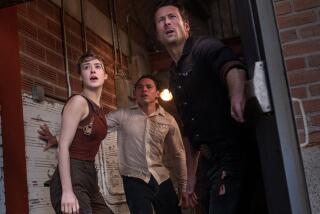A Homemade Radar Station Finds Twisters --Texas-Style
- Share via
CORSICANA, Tex. — When towering thunderstorms threaten, Lloyd Huffman fires up the Doppler radar he built from military surplus parts.
Unlike conventional radar, Doppler can detect the speed and direction of raindrops within a storm, allowing Huffman to spot rotation that could indicate the formation of a tornado and warn the weather service and local authorities.
“It just kind of grew over the years,” Huffman said of the radar he has been tuning up in anticipation of the April-through-June tornado season.
With a few differences--cost being a big one--Huffman’s S-band Doppler is like the NEXRAD system being tested at the National Severe Storms Laboratory in Norman, Okla., and planned for nationwide installation in the coming decade.
Huffman asked the laboratory for the plans to build his Doppler. “After they believed us, they gave us the information we needed,” he said.
‘Very Interested’
Huffman built his first radar station in 1976, using World War II surplus Army and Navy equipment and putting the antenna on the local hospital. He began working in 1979 on the present station, which became Doppler-capable in 1985.
“I’m very interested in thunderstorm structure,” he said.
Huffman, 42, has a degree in physics from North Texas State University. After working as a communications systems designer for Motorola in Dallas, he returned to his hometown in 1974 and started a communications business.
Huffman and his crew staff the station whenever severe weather is possible. He is in microwave link with WFAA-TV in Dallas and talks by radio with National Weather Service meteorologists in Fort Worth.
The radar can detect rain intensity for several hundred miles but can process Doppler information for only about 150 miles. The radar pulses about 1,000 times a second, sending a beam about 1 1/2 degrees wide. The reflected data is sorted into “range bins,” each 150 meters deep.
A computer remembers and compares the location of raindrops, allowing it to determine the speed and direction. “The speed of rotation is the rate of change of phase angle--that’s the velocity,” Huffman explained.
Picture of a Storm
The computer assigns a color to each velocity--red indicates movement toward the station, green is away--painting a picture of the storm. The right combination of colors on the southwest corner of a thunderstorm provides a “meso-cyclone vortex signature,” indicating rotation.
After several minutes of observation and tilting the radar beam up and down, Huffman might spot elongation into a cylinder that could mean a tornado. He then makes sure the National Weather Service knows and uses police-band radios to notify authorities in surrounding counties.
Huffman has the money to upgrade his system by speeding up the computer and adding memory but said “it takes a lot of time. It’s a mechanical, electrical, electronic and computer project; a little of everything involved in in it.”
He calls the project “a good community thing to do.”
It is funded by the Navarro Community Foundation, money from wealthy families that profited from two oil booms. Operating expenses are covered by WFAA-TV in Dallas, which shows the radar during weather broadcasts.
The station sits on an acre provided by the Corsicana Independent School District. A donated 80-foot oil derrick supports a 25-foot-diameter fiberglass dome containing the 16 1/2-foot dish antenna. At the base of the derrick is a building housing the radar and the computer equipment that makes it different from conventional systems.
NEXRAD, costing millions as opposed to Huffman’s $50,000 since 1976, will differ by having built-in computer programs to compare data with regional models and issue an automatic warning of tornado likelihood.
Huffman enjoys being able to interpret his data by himself.
“They’ll never completely replace the man in front of the radar screen,” agreed Weather Service severe storms specialist Al Moller in Ft. Worth. “We have to strike a balance in technology, research and training of people responsible for issuing watches and warnings.”
More to Read
Sign up for Essential California
The most important California stories and recommendations in your inbox every morning.
You may occasionally receive promotional content from the Los Angeles Times.













